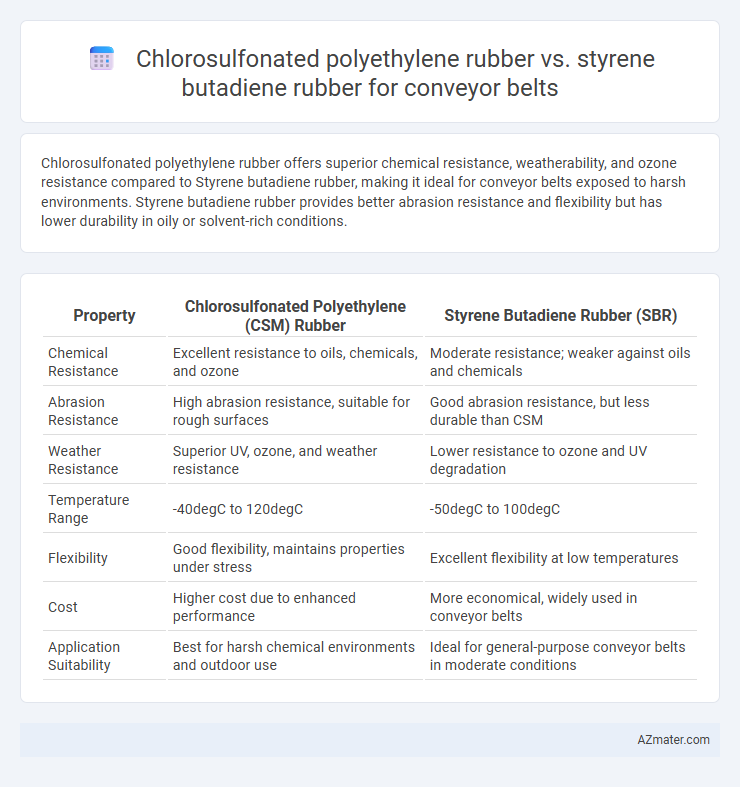Chlorosulfonated polyethylene rubber offers superior chemical resistance, weatherability, and ozone resistance compared to Styrene butadiene rubber, making it ideal for conveyor belts exposed to harsh environments. Styrene butadiene rubber provides better abrasion resistance and flexibility but has lower durability in oily or solvent-rich conditions.
Table of Comparison
| Property | Chlorosulfonated Polyethylene (CSM) Rubber | Styrene Butadiene Rubber (SBR) |
|---|---|---|
| Chemical Resistance | Excellent resistance to oils, chemicals, and ozone | Moderate resistance; weaker against oils and chemicals |
| Abrasion Resistance | High abrasion resistance, suitable for rough surfaces | Good abrasion resistance, but less durable than CSM |
| Weather Resistance | Superior UV, ozone, and weather resistance | Lower resistance to ozone and UV degradation |
| Temperature Range | -40degC to 120degC | -50degC to 100degC |
| Flexibility | Good flexibility, maintains properties under stress | Excellent flexibility at low temperatures |
| Cost | Higher cost due to enhanced performance | More economical, widely used in conveyor belts |
| Application Suitability | Best for harsh chemical environments and outdoor use | Ideal for general-purpose conveyor belts in moderate conditions |
Introduction to Conveyor Belt Rubber Materials
Chlorosulfonated polyethylene (CSPE) rubber offers exceptional resistance to chemicals, ozone, and weathering, making it ideal for conveyor belts operating in harsh industrial environments. Styrene butadiene rubber (SBR) provides strong abrasion resistance and cost-effectiveness, suitable for general-purpose conveyor belts. Selection between CSPE and SBR depends on specific operational demands such as exposure to chemicals, temperature extremes, and mechanical wear.
Overview of Chlorosulfonated Polyethylene Rubber (CSM)
Chlorosulfonated polyethylene rubber (CSM) is a synthetic elastomer known for its exceptional resistance to chemicals, ozone, weathering, and heat, making it ideal for conveyor belt applications in harsh environments. Its high tensile strength, excellent abrasion resistance, and low permeability to gases enhance the durability and lifespan of conveyor belts compared to styrene butadiene rubber (SBR). CSM's ability to maintain flexibility at a wide range of temperatures and withstand exposure to oils, solvents, and UV radiation ensures superior performance in demanding industrial settings.
Understanding Styrene Butadiene Rubber (SBR)
Styrene Butadiene Rubber (SBR) is widely used in conveyor belts for its excellent abrasion resistance, good aging stability, and cost-effectiveness compared to Chlorosulfonated Polyethylene Rubber (CSM). SBR's synthetic polymer structure provides enhanced tensile strength and flexibility, crucial for conveyor belts operating under variable loads and harsh conditions. Its superior wear resistance and ease of processing make SBR a preferred choice in industrial applications requiring durability and performance.
Mechanical Properties: CSM vs SBR
Chlorosulfonated polyethylene (CSM) rubber offers superior resistance to abrasion, ozone, and chemical degradation compared to Styrene butadiene rubber (SBR), making it more durable for conveyor belt applications. CSM also exhibits higher tensile strength and better elongation at break, enhancing overall mechanical performance under continuous stress. SBR provides good heat resistance and resilience but generally shows lower tear strength and aging resistance, limiting its lifespan in demanding conveyor belt environments.
Chemical Resistance Comparison
Chlorosulfonated polyethylene (CSM) rubber exhibits superior chemical resistance against acids, alkalis, oils, and solvents compared to styrene butadiene rubber (SBR), making it highly suitable for conveyor belts exposed to harsh industrial environments. SBR tends to degrade faster when in contact with hydrocarbons and certain chemicals, limiting its durability in corrosive settings. The enhanced chemical stability of CSM ensures longer service life and reduced maintenance costs in conveyor belt applications requiring resistance to aggressive substances.
Temperature and Weathering Performance
Chlorosulfonated polyethylene rubber (CSM) exhibits superior resistance to extreme temperatures and harsh weathering conditions compared to Styrene butadiene rubber (SBR), making it ideal for conveyor belts exposed to outdoor environments. CSM maintains flexibility and durability in temperature ranges from -40degC to 150degC, while SBR typically degrades above 70degC and loses elasticity under prolonged UV exposure. The enhanced chemical structure of CSM provides excellent ozone and UV resistance, significantly extending conveyor belt lifespan in fluctuating climatic conditions.
Abrasion and Wear Resistance
Chlorosulfonated polyethylene (CSM) rubber exhibits superior abrasion and wear resistance compared to Styrene butadiene rubber (SBR), making it highly suitable for conveyor belt applications in abrasive environments. CSM's enhanced chemical stability and resistance to oxidation prolong the belt's lifespan under continuous mechanical stress. While SBR offers good initial wear properties, CSM outperforms it in long-term durability and resistance to surface degradation.
Cost Analysis: CSM vs SBR
Chlorosulfonated polyethylene (CSM) rubber generally incurs higher raw material and processing costs compared to styrene-butadiene rubber (SBR), impacting initial conveyor belt expenses. SBR offers cost-effective manufacturing with adequate resistance properties, making it a budget-friendly option for standard conveyor applications. However, CSM's superior chemical, heat, and ozone resistance can reduce long-term maintenance and replacement costs, potentially offsetting its higher upfront price.
Environmental Impact and Sustainability
Chlorosulfonated polyethylene (CSPE) rubber offers superior chemical resistance and durability, leading to longer conveyor belt lifespans and reduced waste generation compared to Styrene Butadiene Rubber (SBR). CSPE's enhanced resistance to environmental degradation minimizes the frequency of belt replacements, lowering overall carbon emissions and resource consumption throughout the product lifecycle. However, SBR is often more easily recyclable due to its common usage and established recycling processes, which can contribute to sustainability in appropriate industrial contexts.
Choosing the Optimal Rubber for Conveyor Belts
Chlorosulfonated polyethylene rubber (CSM) offers superior resistance to weathering, chemicals, and ozone, making it ideal for conveyor belts exposed to harsh environmental conditions and aggressive substances. Styrene butadiene rubber (SBR) provides excellent abrasion resistance and cost-effectiveness, suitable for conveyor belts in general material handling applications with moderate chemical exposure. Choosing the optimal rubber involves balancing durability requirements, environmental factors, and budget constraints to enhance conveyor belt performance and longevity.

Infographic: Chlorosulfonated polyethylene rubber vs Styrene butadiene rubber for Conveyor belt
 azmater.com
azmater.com